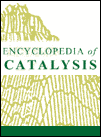Kinetics of Catalyzed Reactions – Homogeneous
Abstract
Catalysts are not static entities, instead they are species that repetitively recycle through at least two forms, and sometimes more. The catalyst opens a new pathway with a lower Gibbs energy of activation; it does not somehow lower the activation energy of an existing pathway. Certain mathematical approaches to the analysis of data from catalytic kinetics are given. Forms that are useful in practice must allow for the coexistence, at comparable concentration, of these three species: the catalyst (C), its complex with substrate (C·S) and very likely with product (C·P). The steady-state approximation often provides a tractable solution, although its form may require one to rely on initial-rate method rather than integration of the reaction progress over its entire time course. A more precise solution can be obtained by methods employing numerical integration or its equivalent, programs for which can be downloaded from the Internet. Some catalytic systems require the consideration of inhibitory phenomena, and the case of competitive, noncompetitive, and uncompetitive inhibition are presented. Data from the very earliest stages of a reaction, before product has accumulated, can provide rate constants for the important catalytst–substrate binding phase.



